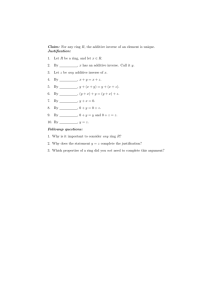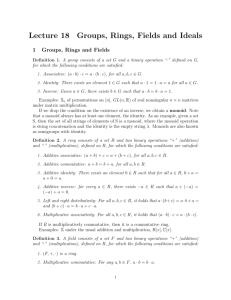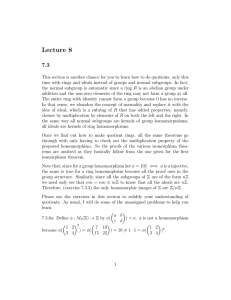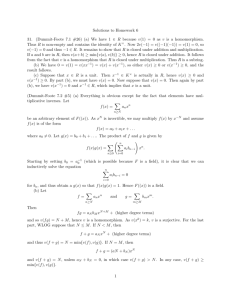Math 330, Abstract Algebra I Solutions to Homework 8 Problems
advertisement
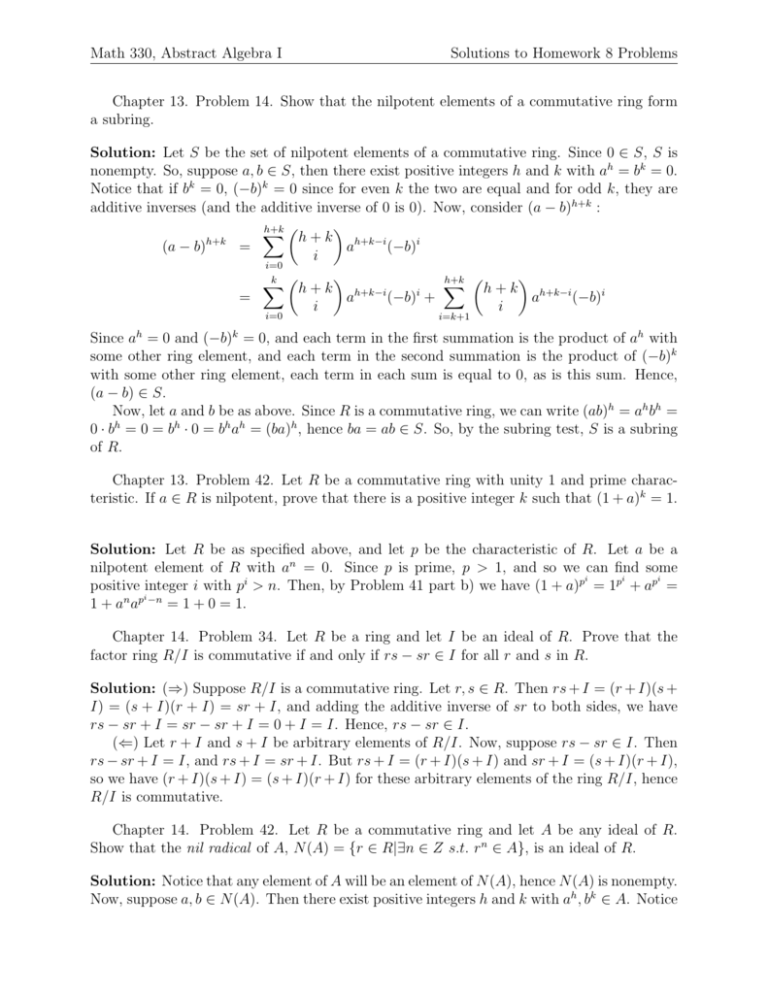
Math 330, Abstract Algebra I
Solutions to Homework 8 Problems
Chapter 13. Problem 14. Show that the nilpotent elements of a commutative ring form
a subring.
Solution: Let S be the set of nilpotent elements of a commutative ring. Since 0 ∈ S, S is
nonempty. So, suppose a, b ∈ S, then there exist positive integers h and k with ah = bk = 0.
Notice that if bk = 0, (−b)k = 0 since for even k the two are equal and for odd k, they are
additive inverses (and the additive inverse of 0 is 0). Now, consider (a − b)h+k :
h+k X
h + k h+k−i
h+k
(a − b)
=
a
(−b)i
i
i=0
k h+k X
X
h + k h+k−i
h + k h+k−i
i
=
a
(−b) +
a
(−b)i
i
i
i=0
i=k+1
Since ah = 0 and (−b)k = 0, and each term in the first summation is the product of ah with
some other ring element, and each term in the second summation is the product of (−b)k
with some other ring element, each term in each sum is equal to 0, as is this sum. Hence,
(a − b) ∈ S.
Now, let a and b be as above. Since R is a commutative ring, we can write (ab)h = ah bh =
0 · bh = 0 = bh · 0 = bh ah = (ba)h , hence ba = ab ∈ S. So, by the subring test, S is a subring
of R.
Chapter 13. Problem 42. Let R be a commutative ring with unity 1 and prime characteristic. If a ∈ R is nilpotent, prove that there is a positive integer k such that (1 + a)k = 1.
Solution: Let R be as specified above, and let p be the characteristic of R. Let a be a
nilpotent element of R with an = 0. Since p is prime, p > 1, and so we can find some
i
i
i
positive integer i with pi > n. Then, by Problem 41 part b) we have (1 + a)p = 1p + ap =
i
1 + an ap −n = 1 + 0 = 1.
Chapter 14. Problem 34. Let R be a ring and let I be an ideal of R. Prove that the
factor ring R/I is commutative if and only if rs − sr ∈ I for all r and s in R.
Solution: (⇒) Suppose R/I is a commutative ring. Let r, s ∈ R. Then rs + I = (r + I)(s +
I) = (s + I)(r + I) = sr + I, and adding the additive inverse of sr to both sides, we have
rs − sr + I = sr − sr + I = 0 + I = I. Hence, rs − sr ∈ I.
(⇐) Let r + I and s + I be arbitrary elements of R/I. Now, suppose rs − sr ∈ I. Then
rs − sr + I = I, and rs + I = sr + I. But rs + I = (r + I)(s + I) and sr + I = (s + I)(r + I),
so we have (r + I)(s + I) = (s + I)(r + I) for these arbitrary elements of the ring R/I, hence
R/I is commutative.
Chapter 14. Problem 42. Let R be a commutative ring and let A be any ideal of R.
Show that the nil radical of A, N (A) = {r ∈ R|∃n ∈ Z s.t. rn ∈ A}, is an ideal of R.
Solution: Notice that any element of A will be an element of N (A), hence N (A) is nonempty.
Now, suppose a, b ∈ N (A). Then there exist positive integers h and k with ah , bk ∈ A. Notice
Math 330, Abstract Algebra I
Solutions to Homework 8 Problems
that if bk ∈ A, so is (−b)k since for even k, (−b)k = bk and for odd k, (−b)k = −bk , and A
is closed under additive inverses. Now, consider (a − b)h+k :
h+k
(a − b)
=
=
h+k X
h+k
i=0
k X
i=0
i
ah+k−i (−b)i
h+k X
h + k h+k−i
h + k h+k−i
i
a
(−b) +
a
(−b)i
i
i
i=k+1
Notice that every term in the first summation is the product of ah with some other ring
element and every term in the second summation is the product of (−b)k with some other
ring element. Since A is an ideal of R and we know ah ∈ A and (−b)k ∈ A, we know that
every term in each summation is contained in A, hence the sum itself is contained in A.
That is, (a − b)h+k ∈ A, hence a − b ∈ N (A).
Now, for a ∈ N (A) and some arbitrary element r ∈ R, we know that there is some
positive integer h with ah ∈ A. Since R is a commutative ring, we can write (ar)h = ah rh =
rh ah = (ra)h , which we know is an element of A, since ah ∈ A and A is an ideal. So, by the
ideal test N (A) is an ideal of R.
Chapter 14. Problem 56. Let R be a commutative ring with unity and let I be a proper
ideal with the property that every element of R that is not in I is a unit of R. Prove that I
is the unique maximal ideal of R.
Solution: Let R and I be given as above. Suppose A is an ideal of R with I ⊂ A ⊆ R (so
that I is properly contained in A). Then there is some element a ∈ A, a 6∈ I. Since a 6∈ I, a
must be a unit. So there is some a−1 ∈ R, and the product of this ring element with a must
be contained in the ideal A: a · a−1 = 1 ∈ A. Since 1 is an element of A, A = R, hence I is
maximal.
Now, suppose B 6= I is a maximal ideal of R. As B is maximal and B 6= I, B is not a
subset of I (for then B ( I ( R implies that B is not maximal). Thus there must be an
element b ∈ B so that b 6∈ I, hence b is a unit. By the above argument, we see that B must
in fact be all of R, as B contains 1. Hence, B is not actually a maximal ideal, and I is, in
fact, the unique maximal ideal of R.


